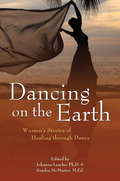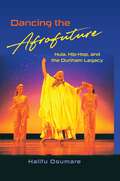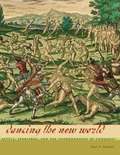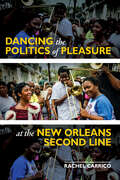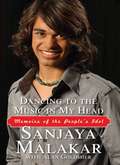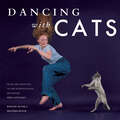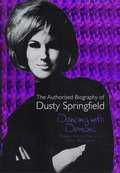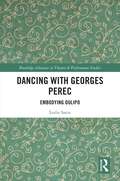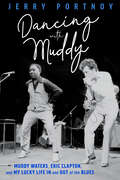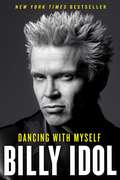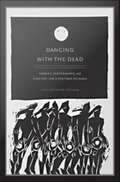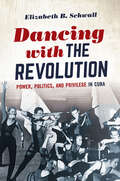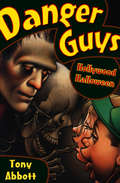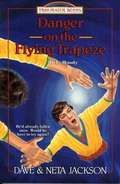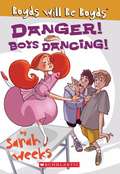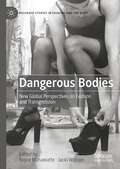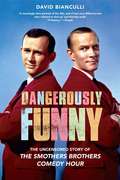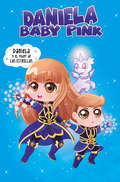- Table View
- List View
Dancing on the Earth
by Sandra Mcmaster Johanna LesehoThe essays in this dynamic compilation are a testament to dance as a healing art. Widely interdisciplinary in nature and written by women dancers from around the world, they illustrate a rich array of dance practices, cultures, and disciplines and show how this expressive therapy can be both empowering and exhilarating. The women's narratives all share a deep appreciation for the connection between mental, spiritual, and physical dimensions, offering dance as a transformative power of renewing and rebuilding that bond. Both personal and professional, the stories weave a vivid tapestry of lived experiences and insights, balance, and a community healed by dance.
Dancing the Afrofuture: Hula, Hip-Hop, and the Dunham Legacy
by Halifu Osumare<p class="MsoNormal" style="margin-bottom:0in;margin-bottom:.0001pt;line-height: normal;mso-pagination:none;mso-layout-grid-align:none;text-autospace:none"><span style="font-size:12.0pt;font-family: "Times New Roman",serif">A Black dancer chronicles her career as a scholar writing the stories of global hip-hop and Black culture <p class="MsoNormal" style="margin-bottom:0in;margin-bottom:.0001pt;line-height: normal;mso-pagination:none;mso-layout-grid-align:none;text-autospace:none"> <p class="MsoNormal" style="margin-bottom:0in;margin-bottom:.0001pt;line-height: normal;mso-pagination:none;mso-layout-grid-align:none;text-autospace:none">Dancing the Afrofuture is the story of a dancer with a long career of artistry and activism who transitioned from performing Black dance to writing it into history as a Black studies scholar. Following the personal journey of her artistic development told in Dancing in Blackness, Halifu Osumare now reflects on how that first career—which began during the 1960s Black Arts Movement—has influenced her growth as an academic, tracing her teaching and research against a political and cultural backdrop that extends to the twenty-first century with Black Lives Matter and a potent speculative Afrofuture. <p class="MsoNormal" style="margin-bottom:0in;margin-bottom:.0001pt;text-indent: .5in;line-height:normal">Osumare describes her decision to step away from full-time involvement in dance and community activism to earn a doctorate in American studies from the University of Hawai‘i. She emulated the model of her mentor Katherine Dunham by studying and performing hula, and her research on hip-hop youth culture took her from Hawai‘i to Africa, Europe, and South America as a professor at the University of California, Davis. Throughout her scholarly career, Osumare has illuminated the resilience of African-descendant peoples through a focus on performance and the lens of Afrofuturism. <p class="MsoNormal" style="margin-bottom:0in;margin-bottom:.0001pt;text-indent: .5in;line-height:normal">Respected for her work as both professional dancer and trailblazing academic, Osumare shares experiences from her second career that show the potential of scholarship in revealing and documenting underrecognized stories of Black dance and global pop culture. In this memoir, Osumare dances across several fields of study while ruminating on how the Black past reveals itself in the Afro-present that is transforming into the Afrofuture. <p class="MsoNormal" style="margin-bottom:0in;margin-bottom:.0001pt;line-height: normal"> <p class="MsoNormal" style="margin-bottom:0in;margin-bottom:.0001pt;line-height: normal">Publication of this work made possible by a Sustaining the Humanities through the American Rescue Plan grant from the National Endowment for the Humanities and a University of California, Davis Edward A. Dickson Emeriti Professorship Award.
Dancing the New World: Aztecs, Spaniards, and the Choreography of Conquest
by Paul A. ScolieriFrom Christopher Columbus to "first anthropologist" Friar Bernardino de Sahagún, fifteenth- and sixteenth-century explorers, conquistadors, clerics, scientists, and travelers wrote about the "Indian" dances they encountered throughout the New World. This was especially true of Spanish missionaries who intensively studied and documented native dances in an attempt to identify and eradicate the "idolatrous" behaviors of the Aztec, the largest indigenous empire in Mesoamerica at the time of its European discovery. Dancing the New World traces the transformation of the Aztec empire into a Spanish colony through written and visual representations of dance in colonial discourse-the vast constellation of chronicles, histories, letters, and travel books by Europeans in and about the New World. Scolieri analyzes how the chroniclers used the Indian dancing body to represent their own experiences of wonder and terror in the New World, as well as to justify, lament, and/or deny their role in its political, spiritual, and physical conquest. He also reveals that Spaniards and Aztecs shared an understanding that dance played an important role in the formation, maintenance, and representation of imperial power, and describes how Spaniards compelled Indians to perform dances that dramatized their own conquest, thereby transforming them into colonial subjects. Scolieri's pathfinding analysis of the vast colonial "dance archive" conclusively demonstrates that dance played a crucial role in one of the defining moments in modern history-the European colonization of the Americas.
Dancing the Politics of Pleasure at the New Orleans Second Line
by Rachel CarricoOn many Sundays, Black New Orleanians dance through city streets in Second Lines. These processions invite would-be spectators to join in, grooving to an ambulatory brass band for several hours. Though an increasingly popular attraction for tourists, parading provides the second liners themselves with a potent public expression of Black resistance. Rachel Carrico examines the parading bodies in motion as a form of negotiating and understanding power. Seeing pleasure as a bodily experience, Carrico reveals how second liners’ moves link joy and liberation, self and communal identities, play and dissent, and reclamations of place. As she shows, dancers’ choices allow them to access the pleasure of reclaiming self and city through motion and rhythm while expanding a sense of the possible in the present and for the future. In-depth and empathetic, Dancing the Politics of Pleasure at the New Orleans Second Line blends analysis with a chorus of Black voices to reveal an indelible facet of Black culture in the Crescent City.
Dancing to the Music in My Head: Memoirs of the People's Idol
by Sanjaya Malakar Alan GoldsherSanjaya Malakar, the most popular contestant on Season Six of American Idol, gives readers a behind-the-scenes look at his meteoric rise to fame on one of the most-watched shows on television.Despite finishing in seventh position, Sanjaya Malakar was the most talked about contestant on the sixth season of the television phenomenon American Idol. Best known for his flamboyant hairstyles and screaming young fans, Sanjaya quickly became a household name. His unique style, soft-spoken demeanor, and ingenious song selections made him a fixture on numerous entertainment programs and magazines and led to a huge and devoted fanbase that still remains today.Here, in Dancing to the Music in My Head, he takes fans behind the scenes and reveals what it's like to star on one of television's most popular shows, and how the experience forever changed his life. In his own words, he shares how he soared from obscurity to worldwide fame, from waiting on line amongst thousands of hopefuls to touring with the Top Ten finalists all across the country and being named one of Time magazine's Most Influential People of the Year in 2007. From attending a dinner at the White House to being the subject of parody on Saturday Night Live, Sanjaya has captured national attention in a way that far exceeds that of most ordinary suburban teenagers.
Dancing with Cats: From The Creators Of The International Best Seller Why Cats Paint
by Heather Busch Burton SilverThe cult classic is back! This 15th anniversary edition keeps all the original mystery and magic of cat dancing delightfully intact. Perpetually ahead of its time, Dancing with Cats presents scores of delightful and inspiring photographs of people and cats engaging in their favorite dance routines as well as moving testimonies of the personal transformations brought about through this uniquely joyous form of human-animal connection. Dancing with Cats will have a new generation of cat lovers (and their cats) jumping for joy--and cutting a rug--in no time.
Dancing with Cats: From the Creators of the International Best Seller Why Cats Paint
by Heather Busch Burton SilverThe cult classic is back! This 15th anniversary edition keeps all the original mystery and magic of cat dancing delightfully intact. Perpetually ahead of its time, Dancing with Cats presents scores of delightful and inspiring photographs of people and cats engaging in their favorite dance routines as well as moving testimonies of the personal transformations brought about through this uniquely joyous form of human-animal connection. Dancing with Cats will have a new generation of cat lovers (and their cats) jumping for joy—and cutting a rug—in no time.
Dancing with Demons
by Penny Valentine Vicki WickhamDusty Springfield made her name in the 60s with a string of top ten hits. Her unique singing style and distinctive bouffant blonde look made her famous throughout the world. Despite a period in the wilderness during the 70s and 80s, she was back at the top in the 90s until her death from cancer in March l999.Born an Irish Catholic in l939, her background set her almost schizophrenically at odds with herself as she realised her sexuality and moved further into the rock world. Both Penny Valentine and Vicki Wickham knew Dusty well, as friend and manager for much of her career. As well as charting her gay relationships, this book also looks candidly at the period of her greatest self-destruction while living in Los Angeles in the 80s. Covering every area of her career with honesty and affection, Dusty is brought vividly to life.
Dancing with Demons
by Penny Valentine Vicki WickhamDusty Springfield made her name in the 60s with a string of top ten hits. Her unique singing style and distinctive bouffant blonde look made her famous throughout the world. Despite a period in the wilderness during the 70s and 80s, she was back at the top in the 90s until her death from cancer in March l999.Born an Irish Catholic in l939, her background set her almost schizophrenically at odds with herself as she realised her sexuality and moved further into the rock world. Both Penny Valentine and Vicki Wickham knew Dusty well, as friend and manager for much of her career. As well as charting her gay relationships, this book also looks candidly at the period of her greatest self-destruction while living in Los Angeles in the 80s. Covering every area of her career with honesty and affection, Dusty is brought vividly to life.
Dancing with Georges Perec: Embodying Oulipo (ISSN)
by Leslie SatinThis book explores the relationship of the life and work of the remarkable Parisian-Jewish writer Georges Perec (1936–1983) to dance."Dancing" addresses art-making parallels and their personal and sociocultural contexts, including Perec’s childhood loss of his parents in the Holocaust and its repercussions in the significance of the body, everydayness, space, and attention permeating his work. This book, emerging from the author Leslie Satin’s perspective as a dancer and scholar, links Perec’s concerns with those of dance and demonstrates that Perec’s work has implications for dance and how we think about it. Moreover, it is framed as a performative autobiographical enactment of the author's relationship to Perec, periodically linking their written, danced, and imagined lives.This exploration will be of great interest to dancers, dance scholars, and dance students interested in contemporary experimental dance and contemporary dance.
Dancing with Merce Cunningham
by Marianne Preger-SimonDancing with Merce Cunningham is a buoyant, captivating memoir of a talented dancer’s lifelong friendship with one of the choreographic geniuses of our time. Dancing with Merce Cunningham is a buoyant, captivating memoir of a talented dancer’s lifelong friendship with one of the choreographic geniuses of our time. Marianne Preger-Simon’s story opens amid the explosion of artistic creativity that followed World War II. While immersed in the vibrant arts scene of postwar Paris during a college year abroad, Preger-Simon was so struck by Merce Cunningham’s unconventional dance style that she joined his classes in New York. She soon became an important member of his brand new dance troupe—and a constant friend. Through her experiences in the Merce Cunningham Dance Company, Preger-Simon offers a rare account of exactly how Cunningham taught and interacted with his students. She describes the puzzled reactions of audiences to the novel non-narrative choreography of the company’s debut performances. She touches on Cunningham’s quicksilver temperament—lamenting his early frustrations with obscurity and the discomfort she suspects he endured in concealing his homosexuality and partnership with composer John Cage—yet she celebrates above all his dependable charm, kindness, and engagement. She also portrays the comradery among the company’s dancers, designers, and musicians, many of whom—including Cage, David Tudor, and Carolyn Brown—would become integral to the avant-garde arts movement, as she tells tales of their adventures touring in a VW Microbus across the United States. Finally, reflecting on her connection with Cunningham throughout the latter part of his career, Preger-Simon recalls warm moments that nurtured their enduring bond after she left the dance company and, later, New York. Interspersed with her letters to friends and family, journal entries, and correspondence from Cunningham himself, Preger-Simon’s memoir is an intimate look at one of the most influential companies in modern American dance and the brilliance of its visionary leader.
Dancing with Muddy: Muddy Waters, Eric Clapton, and My Lucky Life In and Out of the Blues
by Jerry PortnoyJerry Portnoy grew up in Chicago hearing the blues being played outside his father's rug store on famed Maxwell Street during the late 1940s and early '50s. After dropping out of college, he became immersed in the colorful world of pool hustlers like Cornbread Red, and Minnesota Fats as he managed the largest pool hall in Chicago. During a stint as a paratrooper early in the Vietnam war, he applied for discharge as a conscientious objector, and lived in San Francisco during 1967's "summer of love." While bumming around Europe the following year, Portnoy heard the blues again on a record by Sonny Boy Williamson and instantly became obsessed with mastering blues harmonica. He returned to Chicago and in 1974 he was playing in small Black clubs at night when Muddy Waters plucked him from his day job at Cook County Jail to fill the historic harmonica chair in his fabled band. Eric Clapton followed suit in 1991. In a career that took him from ghetto taverns to the White House and the Royal Albert Hall, he went from the raggedy vans and cheap roadside motels of the blues world to the private jets and five-star hotels of the rock world. Between those two very different gigs was a struggle to survive the vagaries of the music business and the pressures of life on the road. In a remarkable life, he also assisted in surgery, lodged in a Moroccan house of ill repute, and dined at Giorgio Armani's. Dancing with Muddy details the surprising, lively, and sometimes bumpy ride of a blues harmonica legend.
Dancing with Myself
by Billy Idol"I am hopelessly divided between the dark and the good, the rebel and the saint, the sex maniac and the monk, the poet and the priest, the demagogue and the populist. Pen to paper, I've put it all down, every bit from the heart.I'm going out on a limb here, so watch my back." --Billy Idol An early architect of punk rock's sound, style, and fury, whose lip-curling sneer and fist-pumping persona vaulted him into pop's mainstream as one of MTV's first megastars, Billy Idol remains, to this day, a true rock 'n' roll icon.Now, in his long-awaited autobiography, Dancing with Myself, Idol delivers an electric, searingly honest account of his journey to fame--from his early days as front man of the pioneering UK punk band Generation X to the decadent life atop the dance-rock kingdom he ruled--delivered with the same in-your-face attitude and fire his fans have embraced for decades. Beyond adding his uniquely qualified perspective to the story of the evolution of rock, Idol is a brash, lively chronicler of his own career.A survivor's tale at its heart, this sometimes chilling and always riveting account of one man's creative drive joining forces with unbridled human desire is unmistakably literary in its character and brave in its sheer willingness to tell. With it, Billy Idol is destined to emerge as one of the great writers among his musical peers.
Dancing with the Dead: Memory, Performance, and Everyday Life in Postwar Okinawa
by Christopher NelsonChallenging conventional understandings of time and memory, Christopher T. Nelson examines how contemporary Okinawans have contested, appropriated, and transformed the burdens and possibilities of the past. Nelson explores the work of a circle of Okinawan storytellers, ethnographers, musicians, and dancers deeply engaged with the legacies of a brutal Japanese colonial era, the almost unimaginable devastation of the Pacific War, and a long American military occupation that still casts its shadow over the islands. The ethnographic research that Nelson conducted in Okinawa in the late 1990s--and his broader effort to understand Okinawans' critical and creative struggles--was inspired by his first visit to the islands in 1985 as a lieutenant in the U. S. Marine Corps. Nelson analyzes the practices of specific performers, showing how memories are recalled, bodies remade, and actions rethought as Okinawans work through fragments of the past in order to reconstruct the fabric of everyday life. Artists such as the popular Okinawan actor and storyteller Fujiki Hayato weave together genres including Japanese stand-up comedy, Okinawan celebratory rituals, and ethnographic studies of war memory, encouraging their audiences to imagine other ways to live in the modern world. Nelson looks at the efforts of performers and activists to wrest the Okinawan past from romantic representations of idyllic rural life in the Japanese media and reactionary appropriations of traditional values by conservative politicians. In his consideration of eisā, the traditional dance for the dead, Nelson finds a practice that reaches beyond the expected boundaries of mourning and commemoration, as the living and the dead come together to create a moment in which a new world might be built from the ruins of the old.
Dancing with the Revolution: Power, Politics, and Privilege in Cuba (Envisioning Cuba)
by Elizabeth B. SchwallElizabeth B. Schwall aligns culture and politics by focusing on an art form that became a darling of the Cuban revolution: dance. In this history of staged performance in ballet, modern dance, and folkloric dance, Schwall analyzes how and why dance artists interacted with republican and, later, revolutionary politics. Drawing on written and visual archives, including intriguing exchanges between dancers and bureaucrats, Schwall argues that Cuban dancers used their bodies and ephemeral, nonverbal choreography to support and critique political regimes and cultural biases.As esteemed artists, Cuban dancers exercised considerable power and influence. They often used their art to posit more radical notions of social justice than political leaders were able or willing to implement. After 1959, while generally promoting revolutionary projects like mass education and internationalist solidarity, they also took risks by challenging racial prejudice, gender norms, and censorship, all of which could affect dancers personally. On a broader level, Schwall shows that dance, too often overlooked in histories of Latin America and the Caribbean, provides fresh perspectives on what it means for people, and nations, to move through the world.
Dancing with the Stars (Ballerina Dreams #5)
by Ann BryantJasmine is thrilled when her ballet teacher says that she should audition to take classes at the Royal Ballet. She knows that her father will not be happy. When he denies her the opportunity, Jasmine is devastated. What will it take to change his mind?
Dancing: The Pleasure, Power, and Art of Movement
by Gerald JonasLooks at the history of dance, dance around the world, and influential dancers and choreographers of the past and present.
Danger Guys: Hollywood Halloween (Danger Guys #3)
by Tony AbbottThe Danger Guys find themselves in a real-life scary movie, and the ending is up to them It&’s Halloween, and best friends Noodle and Zeek have decided to make a horror movie in honor of the holiday. To show the boys how real films are made, Zeek&’s family takes them to Paragon, the oldest studio in Hollywood. During the tour, a huge lightning storm separates Noodle and Zeek from the rest of the group. The two boys suddenly find themselves in a world of famous sets and exciting props. It&’s the perfect location for their own movie! But it turns out that Paragon Studio has more than a little danger—and not just the staged kind. The lightning damaged the studio&’s central control center, and all the electronic props are now going crazy. Noodle and Zeek must battle an evil robot, a sneezing dinosaur, and a deadly mummy in order to find and warn Zeek&’s family. Little do they know that Zeek&’s family is also under attack! With some luck and a lot of movie drama, the Danger Guys show Paragon Studio what real heroes look like. Danger Guys: Hollywood Halloween on Ice is the 3rd book in Danger Guys, but you may enjoy reading the series in any order.
Danger on the Flying Trapeze
by Dave Jackson Neta JacksonA Trailblazer Book. Casey convinces his family to join the circus but a terrifying accident leaves him paralyzed with fear. Through D. L. Moody, he learns that faith in Christ brings true courage.
Danger on the Silver Screen: 50 Films Celebrating Cinema's Greatest Stunts (Turner Classic Movies)
by Scott McGeeTurner Classic Movies presents a heart-racing look into the world of stunt work featuring films that capture the exhilaration of a car chase, the comedy of a well timed prat fall, or the adrenaline rush from a fight scene complete with reviews, behind-the-scenes stories, and hundreds of photographs.Buckle in and join TCM on a action-packed journey through the history of cinema stunt work in Danger on the Silver Screen. This action-packed guide profiles 50 foundational films with insightful commentary on the history, importance, and evolution of an often overlooked element of film: stunt work. With insightful commentary and additional recommendations to expand your repertoire based on your favorites, Danger on the Silver Screen is a one-of-a-kind guide, perfect for film lovers to learn more about or just brush up on their knowledge of stunt work and includes films such as Ben-Hur (1925 & 1959), The Great K&A Train Robbery (1926), Steamboat Bill Jr. (1928), The Thing from Another World (1951), Bullitt (1968), Live and Let Die (1973), The Blues Brothers (1980), Romancing the Stone (1984), The Matrix (1999), The Bourne Supremacy (2004), John Wick (2014), Mission: Impossible—Rogue Nation (2015), Atomic Blonde (2017), and many more.
Danger! Boys Dancing! (Boyds will Be Boyds #3)
by Sarah WeeksNat Boyd and his best friend Boyd Fink have always found a way to maneuver their way out of trouble. But this time, the problem is serious. It's something horrible and frightening beyond any fifth grader's worse fears. This time, it's... dancing. There's no escaping this humiliating class assignment... and what's worse, there's a rumor that the boys will be forced to wear tutus! What's a Boyd to do?
Danger: Diabolik (Cultographies)
by Leon HuntDanger: Diabolik (1968) was adapted from a comic that has been a social phenomenon in Italy for over fifty years, featuring a masked master criminal—part Fantômas, part James Bond—and his elegant companion Eva Kant. The film partially reinvents the character as a countercultural prankster, subverting public officials and the national economy, and places him in a luxurious and futuristic underground hideout and Eva in a series of unforgettable outfits. A commercial disappointment on its original release, Danger: Diabolik's reputation has grown along with that of its director, Mario Bava, the quintessential cult auteur, while the pop-art glamour of its costumes and sets have caught the imagination of such people as Roman Coppola and the Beastie Boys.This study examines its status as a comic-book movie, including its relation both to the original fumetto and to its sister-film, Barbarella. It traces its production and initial reception in Italy, France, the U.S., and the UK, and its cult afterlife as both a pop-art classic and campy "bad film" featured in the final episode of Mystery Science Theatre 3000.
Dangerous Bodies: New Global Perspectives on Fashion and Transgression (Palgrave Studies in Fashion and the Body)
by Jacki Willson Royce MahawatteThis edited book brings together new perspectives on fashion, the body, and politics. The intention of this collection is to explore the cultural intersection between bodies, fashion, and transgression, often in the most unlikely of locations. Bodies are political players in culture and the authors gathered here ask a range of pressing questions. What role do fashioned bodies play in resistance, in meeting governmental boundaries or institutional power? Arguably, fashion is an aspect of modern warfare and style can defend and attack in cultural space. So, how do fashioned bodies occupy the grey area between social control and the resistance to power? This book is interdisciplinary and international, with contributors situated within a broad range of disciplines including Art History and Critical Practice, Cultural Studies, Fashion Critical Studies, Film and Literary Studies, Performance Studies, Politics and International Studies, Sociology, Gender, Queer, LGBTI, and Critical Race Studies.
Dangerously Funny
by David BianculliA dramatic behind-the-scenes look at the rise and fall of The Smothers Brothers Comedy Hour--the provocative, politically charged program that shocked the censors, outraged the White House, and forever changed the face of television. Decades before The Daily Show, The Smothers Brothers Comedy Hour proved there was a place on television for no-holds-barred political comedy with a decidedly antiauthoritarian point of view. Censorship battles, mind-blowing musical performances, and unforgettable sketches defined the show and its era. In this compelling history, veteran entertainment journalist David Bianculli draws on decades worth of original research, including extensive interviews with Tom and Dick Smothers and dozens of other key players, to tell the fascinating story of the show's three-year network run--and the cultural impact that's still being felt today.r movement of the late 1960s. Drawing on extensive original interviews with Tom and Dick Smothers and dozens of other key players -- as well as more than a decade's worth of original research -- Dangerously Funny brings readers behind the scenes for all the battles over censorship, mind-blowing musical performances, and unforgettable sketches that defined the show and its era. David Bianculli delves deep into this never-told story, to find out what really happened and to reveal why this show remains so significant to this day.
Daniela y el poder de las estrellas
by Daniela Baby Pink¡No te pierdas la nueva aventura de Daniela Baby Pink, la peque de YouTube! Después de vencer a los malvados Kabog, Daniela y Koa regresan a Siltora cada noche para continuar con su entrenamiento en el instituto Ilustris. Pero la tranquilidad durará poco. Un nuevo peligro amenaza Siltora: el río subterráneo ha sido envenenado y sus habitantes sufren una extraña enfermedad. Además ¡alguien ha robado el antídoto! Necesitan el polen de las invisibles flores de ikki para fabricar más. Pero ¿cómo se puede encontrar algo que no se ve? ¿Podrá Daniela Baby Pink nuevamente vencer al mal gracias al poder de las estrellas?
